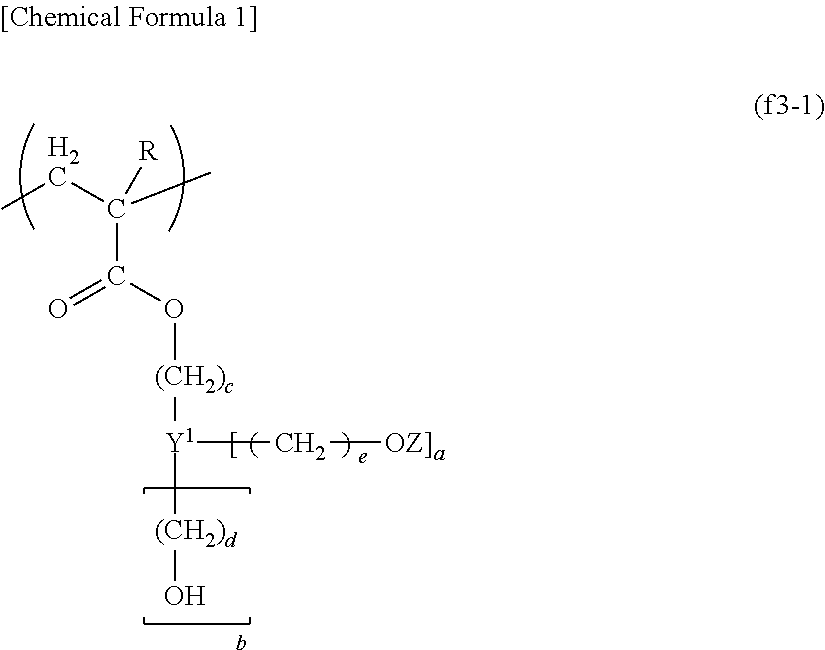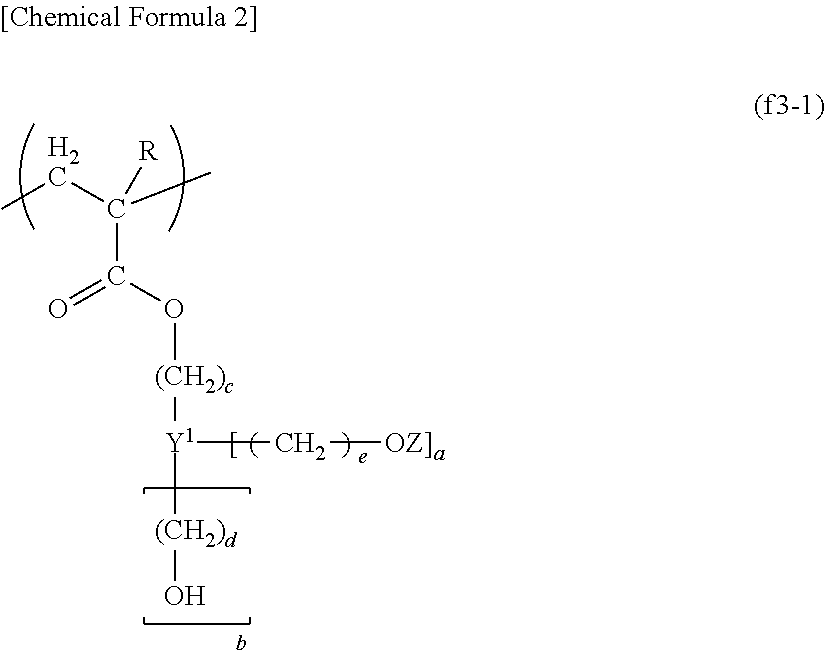Resist composition for immersion exposure, method of forming resist pattern, and fluorine-containing resin
a technology of resist composition and immersion exposure, which is applied in the field of resist composition for immersion exposure, can solve the problems of adversely affecting productivity, affecting the lithography properties, and reducing so as to reduce the elution rate of substances, adversely affecting the lithography properties, and enhancing the hydrophobicity of resist film surfaces
- Summary
- Abstract
- Description
- Claims
- Application Information
AI Technical Summary
Benefits of technology
Problems solved by technology
Method used
Image
Examples
synthesis example 1
Synthesis of Monomer (1)
(i) Synthesis of 7,7,7-trifluoro-3-ethyl-3-heptanol
[1011]1.3 g of magnesium, 10.0 g of 1-bromo-4,4,4-trifluorobutane and 20 g of tetrahydrofuran were added to a four-necked flask equipped with a nitrogen feeding pipe, a reflux condenser, a dropping funnel and a thermometer, and a Grignard reagent was prepared by a conventional method. Then, a mixture containing 5.0 g of 3-pentanone and 4 g of tetrahydrofuran was dropwise added to the obtained Grignard reagent at a temperature of 25 to 35° C. over 30 minutes, followed by stirring at the same temperature for 1 hour. The reaction mixture was treated by a conventional method, and the resulting organic phase was washed with water, followed by drying with anhydrous magnesium sulfate. Thereafter, the resultant was concentrated under reduced pressure, thereby obtaining 7.9 g of 7,7,7-trifluoro-3-ethyl-3-heptanol in the form of a pale yellow oily matter.
(ii) Synthesis of 7,7,7-trifluoro-3-ethyl-3-heptyl methacrylate
[1...
synthesis example 2
Synthesis of Monomer (5)
[1017]61 g (600 mmol) of triethylamine and 64 g (418 mmol) of methyl bromoacetate were added to 300 ml of a THF solution containing 30 g (348 mmol) of methacrylic acid in a nitrogen atmosphere at 0° C., and the temperature was elevated to room temperature, followed by stirring for 3 hours. After conducting thin-layer chromatography (TLC) to confirm that the raw materials had been consumed, the reaction solution was subjected to distillation under reduced pressure to remove the solvent. Then, water was added to the resultant, and extraction was conducted with ethyl acetate three times. The resulting organic phase was washed with water twice, and then subjected to distillation under reduced pressure to remove the solvent, thereby obtaining 47 g of a compound (5)-1 in the form of a colorless liquid (yield: 85%).
[1018]Subsequently, 700 ml of a THF solution containing 30 g (190 mmol) of the compound (5-1) was prepared, and 700 ml of a 2.38% by weight aqueous solut...
synthesis example 3
Synthesis of Monomer (6)
[1028]26 g (180.39 mmol) of a compound (5)-2 was added to 200 ml of a THF solution containing 23.48 g (234.5 mmol) of 2,2,2-trifluoroethanol, 51.9 g (270.6 mmol) of ethyldiisopropylaminocarbodiimide (EDCI) hydrochloride and 0.11 g (0.9 mmol) of dimethylaminopyridine (DMAP) in a nitrogen atmosphere at 0° C., and the temperature was elevated to room temperature, followed by stirring for 3 hours. After conducting thin-layer chromatography (TLC) to confirm that the raw materials had been consumed, the reaction solution was cooled to 0° C., and water was added thereto to stop the reaction. Then, extraction was conducted with ethyl acetate three times, and the obtained organic phase was washed with water twice. Thereafter, the solvent was distilled off under reduced pressure to obtain a crude product, and the obtained crude product was purified by silica gel filtration (using ethyl acetate), thereby obtaining 25 g of a compound (6) in the form of a colorless liquid...
PUM
| Property | Measurement | Unit |
|---|---|---|
| temperature | aaaaa | aaaaa |
| temperature | aaaaa | aaaaa |
| temperature | aaaaa | aaaaa |
Abstract
Description
Claims
Application Information
 Login to View More
Login to View More - R&D
- Intellectual Property
- Life Sciences
- Materials
- Tech Scout
- Unparalleled Data Quality
- Higher Quality Content
- 60% Fewer Hallucinations
Browse by: Latest US Patents, China's latest patents, Technical Efficacy Thesaurus, Application Domain, Technology Topic, Popular Technical Reports.
© 2025 PatSnap. All rights reserved.Legal|Privacy policy|Modern Slavery Act Transparency Statement|Sitemap|About US| Contact US: help@patsnap.com



